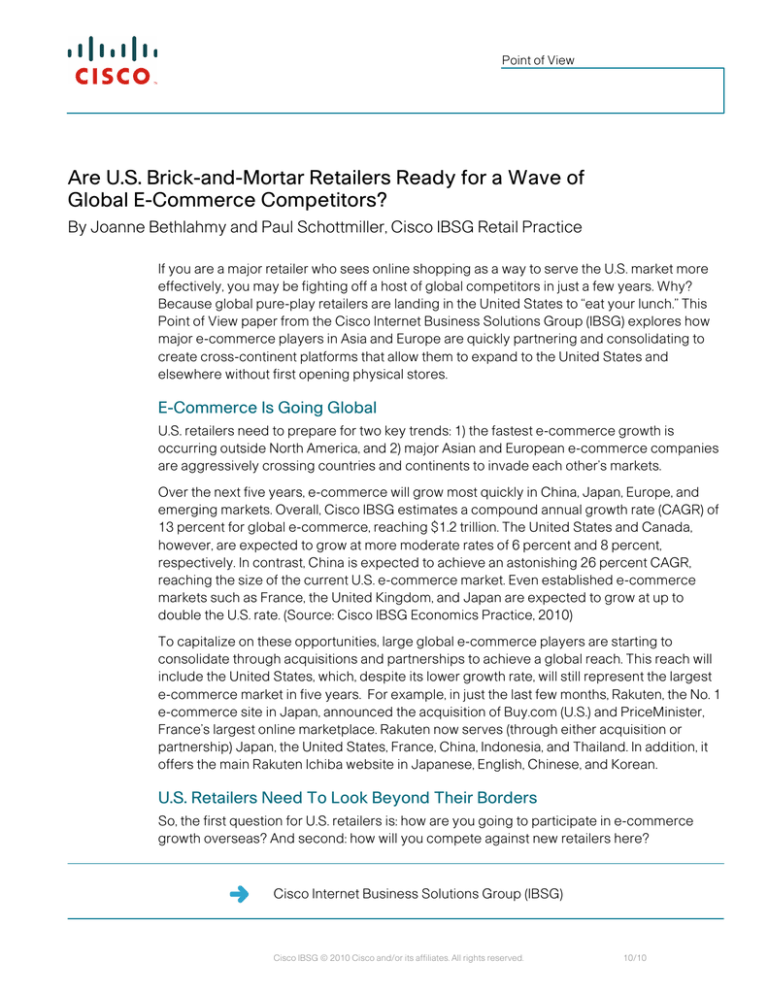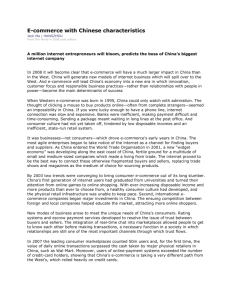
Point of View
Are U.S. Brick-and-Mortar Retailers Ready for a Wave of
Global E-Commerce Competitors?
By Joanne Bethlahmy and Paul Schottmiller, Cisco IBSG Retail Practice
If you are a major retailer who sees online shopping as a way to serve the U.S. market more
effectively, you may be fighting off a host of global competitors in just a few years. Why?
Because global pure-play retailers are landing in the United States to “eat your lunch.” This
Point of View paper from the Cisco Internet Business Solutions Group (IBSG) explores how
major e-commerce players in Asia and Europe are quickly partnering and consolidating to
create cross-continent platforms that allow them to expand to the United States and
elsewhere without first opening physical stores.
E-Commerce Is Going Global
U.S. retailers need to prepare for two key trends: 1) the fastest e-commerce growth is
occurring outside North America, and 2) major Asian and European e-commerce companies
are aggressively crossing countries and continents to invade each other’s markets.
Over the next five years, e-commerce will grow most quickly in China, Japan, Europe, and
emerging markets. Overall, Cisco IBSG estimates a compound annual growth rate (CAGR) of
13 percent for global e-commerce, reaching $1.2 trillion. The United States and Canada,
however, are expected to grow at more moderate rates of 6 percent and 8 percent,
respectively. In contrast, China is expected to achieve an astonishing 26 percent CAGR,
reaching the size of the current U.S. e-commerce market. Even established e-commerce
markets such as France, the United Kingdom, and Japan are expected to grow at up to
double the U.S. rate. (Source: Cisco IBSG Economics Practice, 2010)
To capitalize on these opportunities, large global e-commerce players are starting to
consolidate through acquisitions and partnerships to achieve a global reach. This reach will
include the United States, which, despite its lower growth rate, will still represent the largest
e-commerce market in five years. For example, in just the last few months, Rakuten, the No. 1
e-commerce site in Japan, announced the acquisition of Buy.com (U.S.) and PriceMinister,
France’s largest online marketplace. Rakuten now serves (through either acquisition or
partnership) Japan, the United States, France, China, Indonesia, and Thailand. In addition, it
offers the main Rakuten Ichiba website in Japanese, English, Chinese, and Korean.
U.S. Retailers Need To Look Beyond Their Borders
So, the first question for U.S. retailers is: how are you going to participate in e-commerce
growth overseas? And second: how will you compete against new retailers here?
Cisco Internet Business Solutions Group (IBSG)
Cisco IBSG © 2010 Cisco and/or its affiliates. All rights reserved.
10/10
Point of View
While some U.S. retailers already ship globally from their main site, they rarely offer multilanguage translation or currency-conversion capabilities. By not providing foreign shipping,
translation, or currency-conversion capabilities on their main websites, American retailers
limit purchases by expats and foreign customers who may be attracted to their brands.
In addition, traditional retailers tend to have websites only in countries where they operate
stores—and sometimes not even in these geographies. As a result, they fall behind abroad
and become increasingly surrounded by foreign e-competition at home.
Also, many North American retailers expand stores first into Canada and Mexico (not
expected to be the fastest-growing e-commerce markets) and, therefore, are not participating in higher-growth Asian and European e-commerce markets. Finally, unless U.S.
retailers move quickly, they may miss opportunities to acquire and/or partner with the top
e-commerce players in their category.
Winning Will Require Different Strategic Approach,
New Global Technical Capabilities
Both multichannel and pure-play U.S. retailers need to start thinking of themselves as global
e-commerce retailers. This often requires changing from a North American-centric and
store-centric mind-set by asking the following questions: How can I export my e-commerce
abroad? How can I partner or acquire to enable e-commerce in fast-growing geographies?
How can I scale? How can I fulfill without stores?
One initial step is to make it easy for expats and other foreign shoppers to buy from your
main website. For example, Overstock.com offers a map-based, multi-currency conversion
feature. Many European and Asian sites have multi-language translations of their website to
enable foreign shoppers. Japan’s Navibird.com has an English site and global shipping to
offer Japanese products to the world. Navibird.com also recently expanded into China via
web translation and a partnership with search engine Baidu.
Next, begin to look at geographic expansion from an e-commerce perspective. Where is
your category growing? Where could you bring your unique viewpoint or competencies?
Then, evaluate how best to enter the e-commerce market, considering self-entry, acquisition,
partnership, and use of third-party fulfillment and currency suppliers. Companies such as
FiftyOne, Shipwire, and Borderfree provide a quick way to build cross-border capabilities.
In this e-commerce market, technical platforms must be built not only for global capabilities
such as multiple languages and currencies, but also for rapid scaling and integration of
acquisitions and partnerships. Retailers should not underestimate or underinvest in building
global technology architectures that enable new global e-commerce strategies. A networkbased information and communications technology (ICT) architecture will speed deployment across countries and enable the business variations needed for global expansion.
If you would like further advice on expanding globally, please contact Joanne Bethlahmy or
Paul Schottmiller of the Cisco IBSG Retail Practice.
More Information
Cisco Internet Business Solutions Group (IBSG), the company’s global consultancy, helps leaders of the world’s largest public
and private organizations solve critical business challenges. By connecting strategy, process, and technology, Cisco IBSG
industry experts enable customers to turn visionary ideas into value.
Cisco and the Cisco Logo are trademarks of Cisco Systems, Inc. and/or its affiliates in the U.S. and other countries. A listing of Cisco's trademarks
can be found at www.cisco.com/go/trademarks. Third-party trademarks mentioned are the property of their respective owners. The use of the
word partner does not imply a partnership relationship between Cisco and any other company. (1007R)
Cisco IBSG © 2010 Cisco and/or its affiliates. All rights reserved.
Page 2







